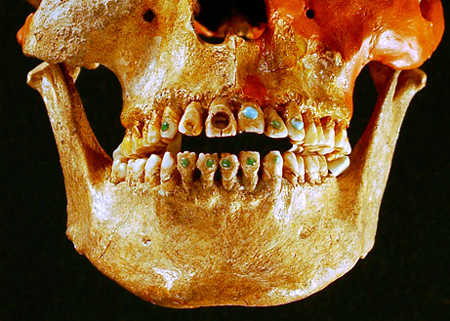The 10 most remarkable scientific findings of the year
Clouds like ocean waves, giant snakes long by bus, human ancestors are three of the most prominent scientific findings in 2009, according to National Geographic.
1. Sharks have huge mouths

Photo: WWF Philippine.
On March 30, Donsol and Philippine residents discovered a shark about 4 meters long on the coast. They arrested it and informed the International Conservation Fund (WWF) office in the Philippines. Animals die immediately after being captured. WWF announced it was a big mouth shark - one of the world's rarest sharks. So far, only 41 individuals of the same species have been found dead, including 7 in the Philippines.
Despite WWF's efforts, the shark is still cut and turned into a dish.
2. People attach precious stones to teeth thousands of years ago

A skull with precious stone teeth in the Mexican Institute of Anthropology and National History.Photo: National Geographic.
Mexico's Institute of Anthropology and National History confirms that Native Americans in the United States know how to attach precious stones to their teeth for beauty about 2,500 years ago. The conclusion was made after the experts of the institute analyzed several thousand precious gemstones they collected. The teeth may lie inside the skull or separate. They affirmed that attaching gemstones to teeth is not a sign to express the social level but only serves beauty purposes. The amazing thing is that the old "dentists" had chiseled their teeth with tools shaped like drill bits to chisel their teeth before attaching gems. These tools are made of hard rock.
3. Giant snakes invade America

A giant green python in the US.This is one of the world's heaviest snakes.Photo: National Geographic.
A scientific report in October found that nine large snake species are expanding in many parts of the United States and could cause catastrophes for the country's animals, plants and ecosystems.
The US Geological Survey said all 9 strange species of snakes in the United States belong to invasive or invasive groups. This means they can survive and reproduce in many different areas. They reach adulthood very quickly and lay many babies. Many animals reach a length of more than 6 m and a volume of up to 90 kg. Their number in the US can range from a few tens of thousands to several hundred thousand individuals.
4. Snakes long on buses

Largest snake artwork in BBC Earth history.
In February, a group of students and faculty at the University of Toronto (Canada) found 180 fossil ribs of 28 snakes at a coal mine in Cerrejó, northeastern Columbia. By comparing the shape and size of the two most complete skeletons with the giant python bone of the South American (Anaconda), they think they weigh up to 1,135 kg and are about 12.8 m long. This snake lives 58 to 60 million years from us and is named Titanoboa cerrejonensis by the team.
With such size and mass, the team thinks that Titanoboa cerrejonensis is the largest snake ever known.
5. Determine "ghost ship" intact after 108 years

The AJ Goddard was still intact after being wrecked 108 years ago.Photo: National Geographic.
AJ Goddard is famous for being one of the few ships built in iron in the 19th century. Its name is associated with trips to the Yukon River, Canada to dig gold. Within three years, AJ Goddard, along with some 260 other steamships, transported tens of thousands of people to the Yukon River. In 1901, the ship suddenly sank in a great storm. During the past century, AJ Goddard's accident has attracted the attention of the scientific community. A group of Canadian archaeologists found its body on the bottom of Lake Laberge, in the Yukon region, Canada. What surprised them was that AJ Goddard was still intact as if he had just sunk from the previous few days.
The things that were scattered on the ship showed the ship's turmoil before sinking. Many people died in the storm. Some people throw away shoes and gowns to jump off the ship.
6. The oldest ancestor of humankind

Artwork of the appearance and gait of the "Ardi" of the BBC.
In October archaeologists from the University of California, USA, published a complete picture of the fossil skeleton of a prehistoric creature who lived in Africa 4.4 million years ago. Fossil skeleton - called Ardipithecus ramidus but referred to as 'Ardi'
Anthropology has always studied chimpanzees (both anatomically and behaviorally) to understand human ancestors. However, Ardi's appearance made all our understanding of human history completely reversed. The analysis shows that Ardi has both the characteristics of humans and ancient primates. However, it is not a chimpanzee or a gorilla. The research team at the University of California thinks Ardi may be a common ancestor of humans and primates today. That means we don't evolve from chimpanzees.
7. Rare and precious birds appear in the Philippines

Luzon quail was sold in the market in the Philippines.Photo: National Geographic.
Luzon quail is thought to live only on the island of Luzon in the Philippines. For many years people have only seen them on paintings in museums that scientists have drawn a few decades ago. The International Union for Conservation of Nature has put Luzon quail on the Red Book. However, many scientists claim they are extinct.
Then in January, a documentary crew accidentally discovered a live Luzon quail on sale in a market in the Philippines. Michael Lu, president of the Philippines Wild Bird Club, thinks it could be the last Luzon quail bird to live. But Birdlife International claims the bird still exists in other areas.
8. Kind of strange cloud

Cloud shaped wave flapping in the sky of the city of Cedar Rapids, Iowa state, USA.Photo: National Geographic.
The clouds in the image look like fluttering waves in the sky. They appear above the city of Cedar Rapids, Iowa State, USA. In fact, this type of cloud has been discovered since 1951.
Gavin Pretor-Pinney, a British cloud enthusiast, asked the World Meteorological Organization to put the cloud in the list of new types of clouds. He also gave them a name in Latin: Undulatus asperatus (meaning rippling, chaotic and intense cloud form).
Margaret LeMone, a cloud expert at the US National Center for Atmospheric Research, said she has photographed the wave-shaped cloud for more than 30 years. LeMone believes that they will be recognized as new clouds.
9. Fish have transparent heads

Fish eye barrel.Photo: Livescience.
Possessing a head like the cockpit of a fighter jet, the barrel eye fish (Macropinna microstoma) is one of the most exotic marine animals on the planet. They live in dark environments on the sea floor, where sunlight cannot reach. The body of the barrel eye is about 15 cm long.
Experts at Monterey Bay Marine Research Institute (USA) use videos recorded by a remote control device to study barrel eye fish in California waters this year. At a depth of 600-800 meters, this fish often keeps its body immobile, while its eyes emit green light. An unprecedented trait in barrel fish is their eyes surrounded by a transparent, fluid-filled barrier. This shield covers the top of the head.
10. The link is missing in the evolutionary history of mankind

Ida is the link between high-level primates and other primates.Photo: National Geographic.
Scientists have long wanted to know how high primates (like monkeys and humans) separated from other primates (including lemurs) in the evolutionary process. But for decades they haven't found a clue about that separation.
Then in May international paleontologists announced they found fossil skeletons of a human-like creature dating back 47 million years in Germany. The team claims Ida - the fossil name - is the species that plays the "link" in the evolution of primates that scientists have been searching for for decades. Ida immediately became a hot topic in the media around the world.
Philip Gingerich, a University of Michigan paleontologist, said Ida is a bridge between high-level primates such as monkeys, humans and primates that have them far away from humans like lemurs.
"This is the creature that has the closest relationship to the direct ancestors of humans," said paleontologist Jorn Hurum, who led the study.
- Breakthrough scientific findings in 2016
- Video: Forecast of outstanding scientific achievements in 2018
- Outstanding scientific findings in 2015
- New findings may help predict volcanic activity
- 10 most impressive findings in 2010
- 10 typical scientific discoveries in 2009
- Binh Tuat 2006 Information Technology - Communication, a memorable year
- Looking back at the outstanding scientific events in 2015
- 10 scientific breakthroughs in 2005
- Top 10 most important scientific findings of the decade
- 10 outstanding scientific events in 2017
- 'Mutant' and patent patent
 Vietnam 5th Asian champion on fuel-efficient vehicles
Vietnam 5th Asian champion on fuel-efficient vehicles We can read all NASA studies completely free of charge
We can read all NASA studies completely free of charge Singer and songwriter Bob Dylan won the 2016 Nobel Prize for Literature
Singer and songwriter Bob Dylan won the 2016 Nobel Prize for Literature Scientific revolution in Asia
Scientific revolution in Asia